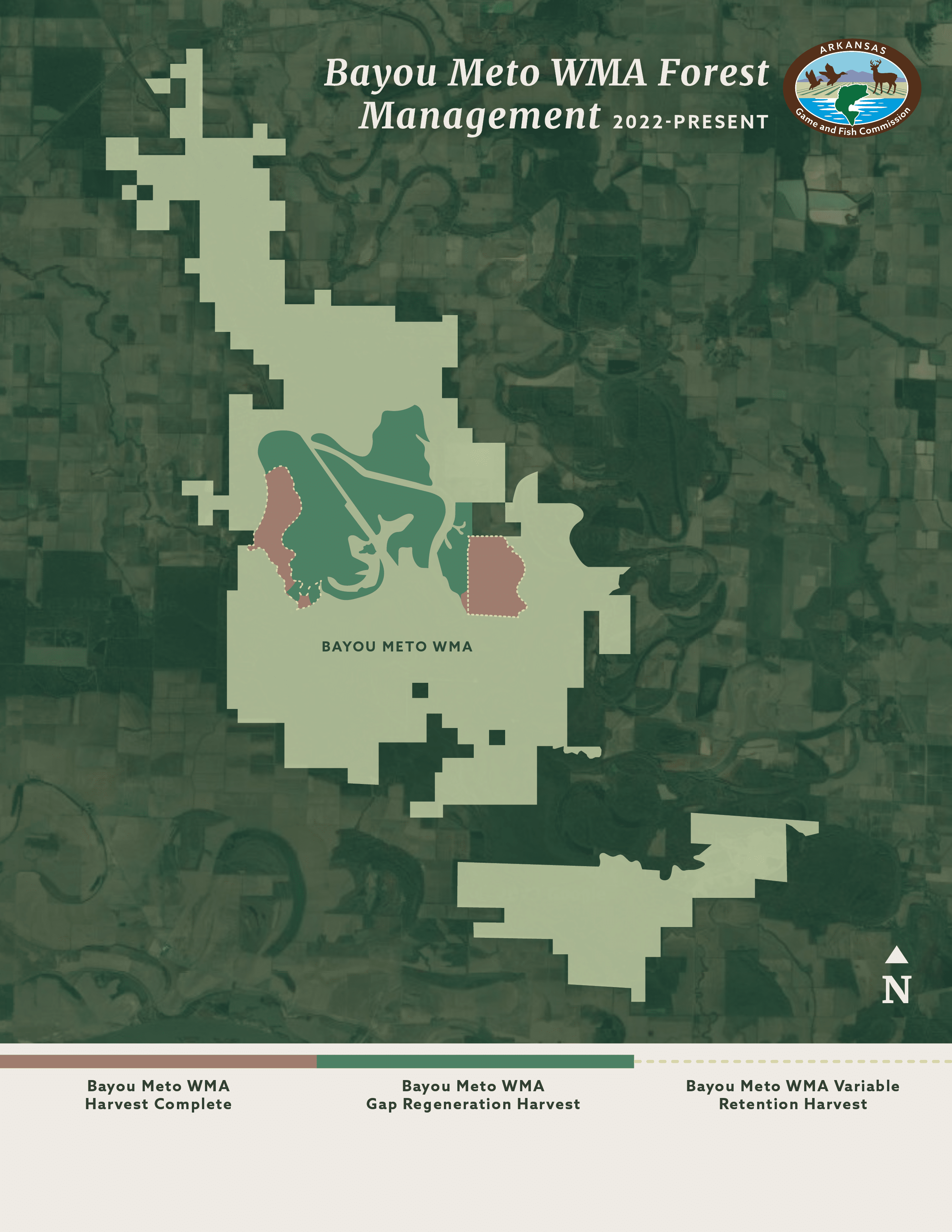Bayou Meto WMA Habitat Project
Bayou Meto WMA Habitat Project Updates
Timber harvest in the Government Cypress Greentree Reservoir concluded for this season in early November. This has been a continuation of forest management that began in 2023. Harvest is complete 612 acres of the 665 acres within the project area. On December 10, 2024 The last load of forest products were hauled from the staging area adjacent to Longbell Road.
Bayou Meto Wildlife Management Area – Current Forest Management Summary
Upper Vallier and Government Cypress Green Tree Reservoir (GTR) (178.5 – 180.0 msl) – Current forest management is occurring on sites categorized utilizing the Arkansas Wildlife Action Plan land classification system for terrestrial habitats. Treatment sites in this area are classified as Lower Mississippi River Low Bottomland Forest. Low bottomland forests are usually seasonally flooded in backswamps, with flooding more frequent than every 5 years, usually more frequently than every two years, generally by still water that may be impounded behind natural levees, and are classed as Low Gradient Riverine Backwater wetlands in hydrogeomorphic classifications. Low bottomlands occur along the Mississippi River and its tributaries in the Mississippi Alluvial Plain Ecoregion. Prolonged flooding dominates this system, and its duration is greater that in the adjacent Mississippi River Riparian Forest. Overcup oak and willow oak are the characteristic dominant species. Soils are clayey with poor internal drainage. Historically, regeneration was through small treefall gaps or large tornado tracks.
Upper Vallier GTR
Overcup oak, willow oak and bitter pecan are the dominant species by order of prevalence. Recent forest health data indicates red oak species are exhibiting moderate stress throughout all elevations of this GTR, with heavy stress being expressed the greatest at elevations of 178.6 to 179.5 msl. Overcup oak, willow oak, green ash and cedar elm are the most prevalent sub-merchantable species. Wind throw of individual dominant and codominant trees, due to compromised root systems, have provided favorable conditions for limited regeneration of willow oak.
Government Cypress GTR
Willow oak, overcup oak and green ash are the dominant species by order of prevalence. Cedar elm, green ash and American elm are the most prevalent sub-merchantable species. Recent forest health data indicate red oak species are exhibiting moderate stress throughout the GTR.
Silvicultural techniques will be the primary tools utilized to manipulate forest structure and species composition in order to provide favorable conditions for red oak regeneration and achieve Desired Forest Conditions (DFCs), which will result in increased cover and species diversity on the ground. DFCs are predetermined forest metrics that are appropriate for a specific land classification. These may include canopy closure, mid-story density, species composition and basal area. The desired conditions vary by land classification and are designed to ensure forest sustainability and diverse species composition appropriate for the site.
Upper Vallier GTR – continuation of timber harvest at 178.5 to 180.0 msl
-
- Variable retention harvest – 730 acres is complete.
- Gap regeneration harvest and intermediate thinning between gaps – 1,492 acres; anticipated to be active in 2025.
Government Cypress GTR – timber harvest at 178.5 to 180.0 msl
-
- Variable retention harvest – 660 acres; 612 acres of the 665 acres is complete.
Government Cypress GTR
-
- Gap regeneration harvest and intermediate thinning between gaps – 823 acres
The Arkansas Wildlife Action Plan identifies species of greatest conservation need for Arkansas.
SGCN are species that are rare, declining, or for which we have very little information on population
status.
The identification of SGCN is part of a process to identify species and groups of species that will be the focus of programs and projects supported by federal funding under the State Wildlife Grant program. Federally-listed species that occur in Arkansas are included on the list of SGCN and addressed by this strategy. However, such species are eligible for funding by sources other than State Wildlife Grants.
SGCN known from Bayou Meto WMA:
– Eastern Whip-poor-will
– Rafinesque’s Big-Eared Bat
– Bird-voiced Treefrog
– Squirrel Treefrog
– Southeastern Bat
– Mole Salamander
– American Black Duck
– Chimney Swift
– Yellow-billed Cuckoo
– Chicken Turtle
– Tricolored Heron
– Swallow-tailed Kite
– Rusty Blackbird
– Purple Finch
– Wood Thrush
– Glossy Swampsnake
– Giant Stag Beetle
– Yellow-crowned Night-Heron
– Graham’s Crayfish Snake
– American Woodcock
– Sharp-shinned Hawk
– Black-crowned Night-Heron
– Cerulean Warbler
– Southern Bog Lemming
– Long-tailed Weasel

